The first draft of this article was written on an Apple iPod while sitting next to the pool in Gran Canaria. While the daily papers entertained my fellow holiday makers with news from back home I, on the other hand, was reading a thriller with all of the ingredients of a best seller, involving sex, deception and life over death. That thriller was the Theoretical Genetics chapter of E. B. Ford's classic Butterflies [Ford].
 |  |
| Edmund Brisco Ford |
The more I read, the more questions I had, subsequently consulting many other references in order free myself from a web of ignorance and intrigue. This article is the end result of a long journey that originally started when I was studying for my biology A-level, after which my interest in genetics (and variation) was put on hold for 30 years while I pursued a completely different career (and raised a family). I'm pleased to say that the topic is back at the forefront of my interests and has really made my butterfly-watching much more enjoyable as a result.
No longer do I view a valesina Silver-washed Fritillary simply as a rare form of the female, but the sex-linked expression of a dominant gene that is only found in a small percentage of the population (not at all in some regions) and that is at a disadvantage in its environment when compared with the normal female form. If this all sounds like gobbledegook then read on. Rest assured that all scientific terms will be explained in due course.
Variation: A difference between individuals of the same species.
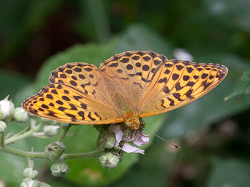 | 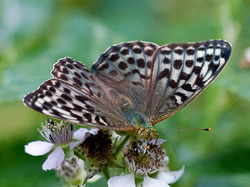 |
| Female Silver-washed Fritillary Image © Peter Eeles | Female Silver-washed Fritillary f. valesina Image © Peter Eeles |
Finally, I'd like to express my thanks to the many members of the UK Butterflies community who have provided many thought-provoking questions regarding variation on the UK Butterflies forums over the years. I would specifically like to thank the army of photographers whose wonderful images have been used in this article. They are Adrian Riley, Agnes Rutter, Colin Baker, Gary Palmer, Gary Richardson, Judith Beads, Matthew Oates, Neil Hulme, Nick Sampford, Paul Kipling, Susie Milbank, Trevor Sawyer and Vince Massimo. Unfortunately, Nick Sampford passed away several years ago, and so my thanks go to his wife, Angela, for kindly donating his photos to UK Butterflies. I'd also like to express my thanks to the British Museum of Natural History for their permission to use images of their collections.
I'd also like to thank Piers Vigus whose deep understanding of this subject area has been a real inspiration - so much so, that I decided to write this article on the subject! And, of course, I'd like to acknowledge the "giants" in the world of Lepidoptera whose literary works have provided me with so much insight into the subject of variation - as listed in the References section at the end of this article. And a final thanks to Guy Padfield, Piers Vigus and Susie Milbank for their comments on an early draft of this article.
So why should we care about variation? Firstly, it gives a better appreciation of the diversity found within our butterfly fauna such as differences between sexes, seasonal forms, subspecies and aberrations, thereby increasing our enjoyment (all of which are explained later in this article). Secondly, our observations and records can contribute to genuine scientific study, such as providing evidence of the density and distribution of varieties within populations. Reflecting an earlier era, when collecting was the norm, Ford also suggests that a study of variation (and the underlying genetics, in particular) can aid collectors in their quest for "desirable varieties" through appropriate captive rearing.
Having mulled things over for quite some time in preparing this article, I'd like to suggest a more-compelling argument which stems from scientific study - the study of variation can, fundamentally, contribute to the conservation of our planet's rich biodiversity. Many variations (specifically, those that are passed from generation to generation) stem from a gene pool that has evolved over millions of years - the earliest fossilised butterfly is estimated to be 50 million years old [Vane-Wright]. I therefore believe that we have a responsibility to not only save threatened species, but also the variations that stem from the same gene pool, not least because some of these are potentially "species in the making" and rightly deserve our protection.
Let me provide a specific example that's close to home. It's a sad fact that, although we may not have lost any species that are endemic to (only found in) the British Isles, we certainly have lost endemic subspecies.
I had the pleasure of visiting the British Museum of Natural History (to give its full title) earlier this year and got to see, for the first time, set (pinned) specimens of the subspecies of Large Copper that was endemic to the British Isles (Lycaena dispar ssp. dispar). I was shocked at the size of the specimens (which are huge when compared with other European subspecies of the Large Copper - ssp. batavus and ssp. rutilus) but even more shocked that we could drive such a beautiful creature to extinction (due to the drainage of the fenland habitat in which it was found). This subspecies is gone for good and is never coming back.
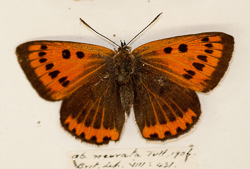 |
| Gone for good - a female British Large Copper (Lycaena dispar ssp. dispar) Image © Peter Eeles |
Some of the later discussion is going to get quite detailed, so I thought I'd whet your appetite in the hope that you "hang in there" before the finale. This section describes some examples of variation, many of which will be familiar. As you read this section, I hope you're constantly asking yourself "why" and "how" each type of variation occurs because that's exactly what will be answered later in this article.
Throughout this article, the terms aberration, form, subspecies and species will be used. Unfortunately, there are differing opinions of what each of these terms means; literature is littered with inconsistencies. I therefore offer a very simple definition of each for the purposes of this article. For completeness, the term population is also defined.
Species: A group of organisms capable of interbreeding and producing fertile offspring.
Subspecies: Populations of a given species that share distinct morphological and/or genetic characters, separating them from other populations. The population is invariably isolated from other populations. An example is the subspecies ssp. caernensis which is the subspecies of Silver-studded Blue found on the Great Orme.
Form: The term applied to dimorphism (where a butterfly occurs in two or more distinct colour types) [Vigus]. Sexual dimorphism, seasonal dimorphism and geographic dimorphism are often described using named forms. An example of sexual dimorphism is the form f. valesina of the female Silver-washed Fritillary. An example of seasonal dimorphism is the form f. hutchinsoni of the Comma. An example of geographic dimorphism is the form f. scotica of the Mountain Ringlet.
Aberration: An individual that differs from the norm. An aberration is usually a "one off" in the sense that it does not recur predictably. An example is the Ringlet aberration ab. lanceolata in which the rings are teardrop-shaped.
Population: A group of individuals of a particular species that is separated to some extent, either in space or in time, from other groups of the same species [Warren]. A population is also characterised as a group of individuals that is able to reproduce within itself.
Possibly the most widely observed form of variation is sexual dimorphism between the two sexes of a given species. The distinction, however, can range from insignificant to significant as shown in the table below, where the highly-subjective groupings are Insignificant (careful examination of the individual is required, looking for specific determining characteristics), Subtle (a cursory examination of an individual can determine sex), Noticeable (simple to determine sex, even in flight) and Significant (the sexes so different they could be mistaken for different species). The subjectivity of the groupings arises because this is my table and it changes over time as I gain more experience - with species moving from one group to another.
| Insignificant | Subtle | Noticeable | Significant |
|---|---|---|---|
| American Painted Lady Brown Argus Camberwell Beauty Comma Green Hairstreak Large Heath Large Tortoiseshell Northern Brown Argus Painted Lady Peacock Red Admiral Ringlet Small Copper Small Heath Small Tortoiseshell Speckled Wood Swallowtail White Admiral |
Black Hairstreak Brown Hairstreak Chequered Skipper Clouded Yellow Cryptic Wood White Dark Green Fritillary Dingy Skipper Duke of Burgundy Essex Skipper Glanville Fritillary Grayling Grizzled Skipper Heath Fritillary High Brown Fritillary Large Blue Lulworth Skipper Marbled White Marsh Fritillary Monarch Mountain Ringlet Pearl-bordered Fritillary Queen of Spain Fritillary Scotch Argus Small Blue Small Pearl-bordered Fritillary Small Skipper White-letter Hairstreak Wood White |
Bath White Berger's Clouded Yellow Black-veined White Brimstone Gatekeeper Green-veined White Holly Blue Large Skipper Large White Long-tailed Blue Meadow Brown Pale Clouded Yellow Purple Emperor Purple Hairstreak Short-tailed Blue Silver-spotted Skipper Silver-washed Fritillary Small White Wall |
Adonis Blue Chalkhill Blue Common Blue Large Copper Mazarine Blue Orange-tip Silver-studded Blue |
At one end of the spectrum we have species where sexual dimorphism is insignificant. This end of the spectrum includes the Vanessids such as Comma, Painted Lady, Peacock, Red Admiral and Small Tortoiseshell. At the other end of the spectrum, we have several blues where the male is primarily blue and the typical female is primarily brown (such as Adonis Blue, Chalkhill Blue, Common Blue and Silver-studded Blue). Examples from each grouping are shown below.
| Insignificant | Peacock (male or female?) |
 |
|
|---|---|---|---|
| Subtle | Duke of Burgundy (male and female) |
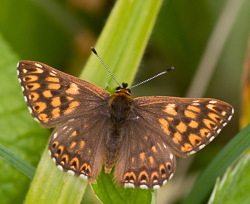 |
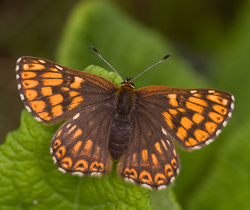 |
| Noticeable | Gatekeeper (male and female) |
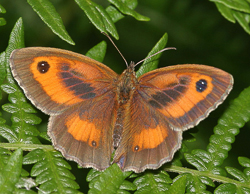 |
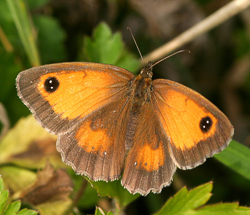 |
| Significant | Adonis Blue (male and female) |
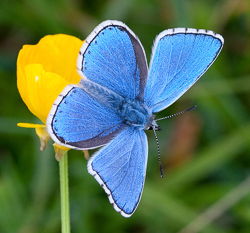 |
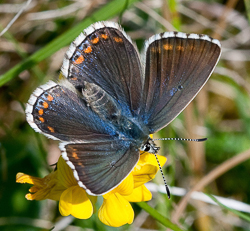 |
| All Photos © Peter Eeles | |||
A point to remember is that we can often determine the sex of an individual based on its behaviour rather than its appearance. For example, while it may be difficult to distinguish between male and female Small Copper, it is the male sets up a territory, darting out at every passing insect to determine if it's a potential mate or an intruding male. The female is much more sedentary.
One final observation we can make is that there are two species found in the British Isles that produce forms that are sex-linked in the sense that they only occur in the female of the species. This is the Silver-washed Fritillary (the valesina form shown earlier) and the Clouded Yellow (where the helice form is a creamy white, rather than the usual orange).
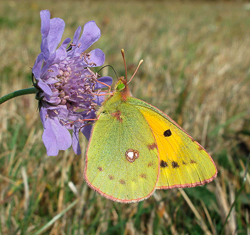 | 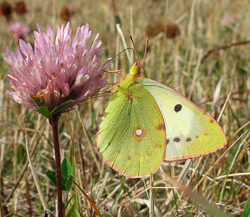 |
| Female Clouded Yellow Image © Vince Massimo | Female Clouded Yellow f. helice Image © Vince Massimo |
We can also observe variation between populations found in different geographies. In the British Isles, most of the differences between such populations are subtle, although there are some notable exceptions as shown in the table below (where each species listed has at least one corresponding form or subspecies).
| Subtle | Significant |
|---|---|
| Brimstone Dingy Skipper Grayling Green-veined White Marsh Fritillary Meadow Brown Mountain Ringlet Orange-tip Scotch Argus Small Copper Small Heath Small Pearl-bordered Fritillary Wood White |
Common Blue Dark Green Fritillary Large Heath Northern Brown Argus Silver-studded Blue Speckled Wood |
One of these is the Large Heath where three recognised subtaxa have been described based on the significance of the spots found on the underside of the hindwing (a subtaxon is a subspecies or form). Individuals found in northern Scotland are ssp. scotica, and have few spots on the underside. Individuals in north-west England are f. davus and are the darkest and most colourful of forms. An intermediate form, f. polydama, is found in northern England, Wales and Ireland.
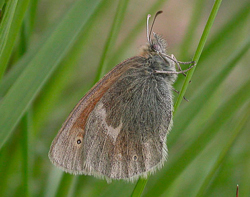 | 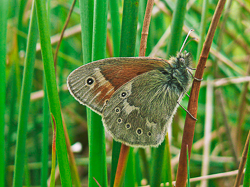 | 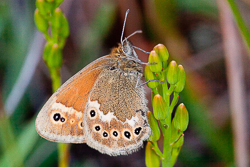 |
| Large Heath ssp. scotica Image © Adrian Riley | Large Heath f. polydama Image © Paul Kipling | Large Heath f. davus Image © Peter Eeles |
Another example is the Silver-studded Blue that exhibits variation from the norm in several populations. One of the most well-known is ssp. caernensis which is restricted to the Great Orme in Caernarvonshire, North Wales. This subspecies is noted for its small size, the amount of blue found in the female and its early flight period.
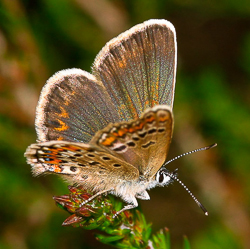 | 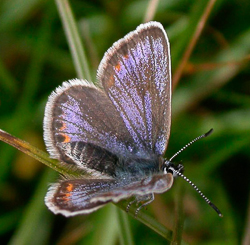 |
| Female Silver-studded Blue Image © Peter Eeles | Female Silver-studded Blue ssp. caernensis Image © Adrian Riley |
Another example that is a little less obvious is in the Northern Brown Argus where the subspecies found in Scotland (ssp. artaxerxes) is characterised by having a white spot on the forewing that distinguishes it from the population found in northern England (ssp. salmacis).
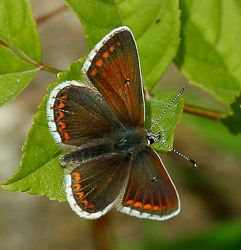 | 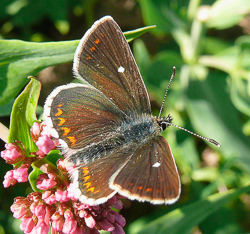 |
| Northern Brown Argus ssp. salmacis Image © Nick Sampford | Northern Brown Argus ssp. artaxerxes Image © Paul Kipling |
Of course, seasonal dimorphism can only occur in those species that have more than one brood each year - ruling out quite a few species. Again, such variation ranges from insignificant to significant. The Map butterfly is included in the table below (which lists all species that regularly have more than one brood each year) since, although only having a precarious claim to being British (it was deliberately introduced at one point), it does exhibit an extreme form of seasonal variation and is therefore worth mentioning.
| Insignificant | Noticeable | Significant |
|---|---|---|
| Adonis Blue Brown Argus Clouded Yellow Common Blue Cryptic Wood White Painted Lady Small Blue Small Copper Small Heath Small Pearl-bordered Fritillary Small Tortoiseshell Swallowtail Wall |
Comma Green-veined White Holly Blue Large White Small White Speckled Wood Wood White |
(Map) |
In the Holly Blue, the females of the spring brood are less heavily-marked than those of the summer brood.
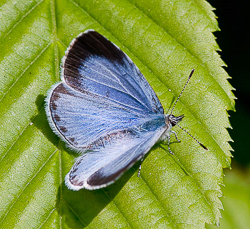 | 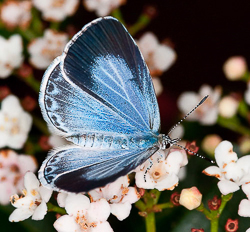 |
| Female Holly Blue (spring brood) Image © Peter Eeles | Female Holly Blue (summer brood) Image © Peter Eeles |
In the Comma, those individuals of the first brood that will go on to produce a second brood are known as the form hutchinsoni. These individuals are much paler in colour than adults that overwinter.
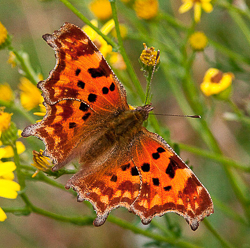 | 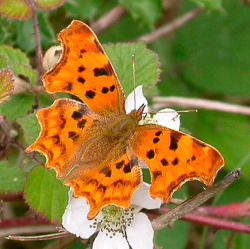 |
| Comma Image © Peter Eeles | Comma f. hutchinsoni Image © Adrian Riley |
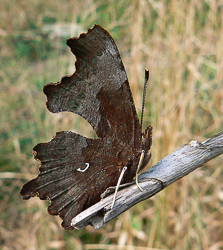 | 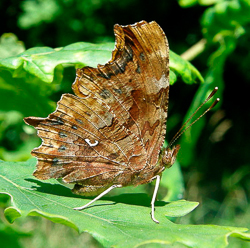 |
| Comma Image © Neil Hulme | Comma f. hutchinsoni Image © Vince Massimo |
This Map has two forms, levana and prorsa that represent the spring and summer broods respectively. levana individuals are primarily orange in colour, giving them the appearance of a small fritillary, whereas prorsa individuals look more like a very small White Admiral.
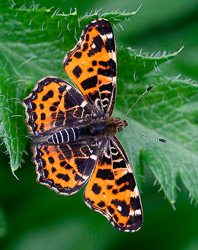 | 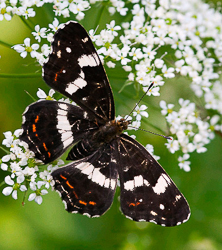 |
| Map f. levana Image © Peter Eeles | Map f. prorsa Image © Peter Eeles |
As defined earlier, an aberration is usually a "one off". However, it's also certainly true that some aberrations are commoner than others. One of the commonest aberrations has to be ab. caeruleopunctata in the Small Copper. In this aberration, there is a row of blue spots above the copper marginal band on the hindwing. However, I've come across populations where almost every individual was of this "aberration".
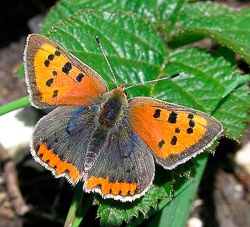 | 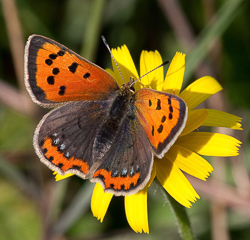 |
| Small Copper Image © Vince Massimo | Small Copper ab. caeruleopunctata Image © Peter Eeles |
Other aberrations occur with differing frequencies and many are extremely rare, not being reported at all in some years. Keeping with Small Coppers, ab. schmidtii is an extremely rare creature, but one was seen in 2009 and two more were reported in 2010.
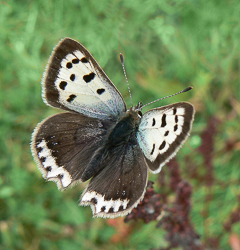 | 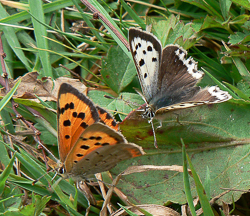 |
| Small Copper ab. schmidtii Image © Neil Hulme | Normal and ab. Schmidtii Small Copper Image © Neil Hulme |
Other aberrations aren't simply a change of colour, but a change of markings (or both). 2009 was an excellent year for aberrations in general, as noted in Piers Vigus' excellent article in the 2009 Hampshire and Isle of Wight Butterfly and Moth Report [Vigus], which contains several such examples. One of the most spectacular aberrations was captured on camera by Matthew Oates - a Purple Emperor ab. lugenda, where the majority of white markings are missing. This is another extraordinarily rare creature.
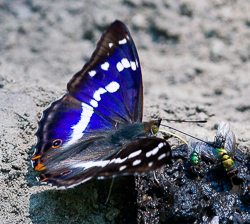 | 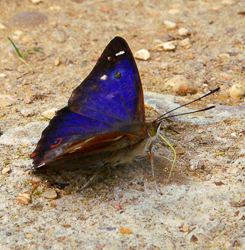 |
| Male Purple Emperor Image © Peter Eeles | Male Purple Emperor ab. lugenda Image © Matthew Oates |
Another example of an aberration affecting markings is the Silver-washed Fritillary ab. ocellata is shown below.
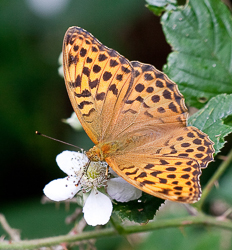 | 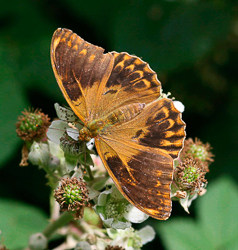 |
| Female Silver-washed Fritillary Image © Peter Eeles | Female Silver-washed Fritillary ab. ocellata Image © Colin Baker |
Most aberrations are symmetrical. However, an asymmetrical aberration turns up every now and again. Assuming that this is not simply a deformity or damaged wing then these individuals often exhibit elements of both sexes and are known as mixed or mosaic gynandromorphs (derived from the Greek gyne and andro, meaning female and male respectively). Three examples are shown below.
The first example is a female Adonis Blue with a hint of male colouring. The second is an extremely rare bilateral gynandromorph where one half is male and the other female - in this case, a Silver-washed Fritillary (left side female, right side male). The third is an even more startling bilateral gynandromorph - in this case, an Orange-tip (left side male, right side female, courtesy of the British Museum of Natural History). Such creatures must lead a very muddled life (but have no chance of reproducing).
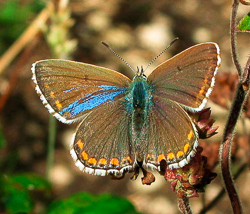 | 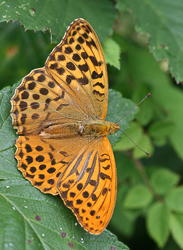 | 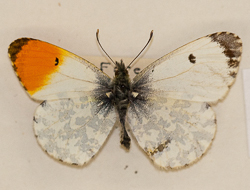 |
| Adonis Blue Mixed Gynandromorph Image © Vince Massimo | Silver-washed Fritillary Bilateral Gynandromorph Image © Susie Milbank | Orange-tip Bilateral Gynandromorph Image © Peter Eeles |
Another category of aberration is a hybrid, which is the (usually infertile) offspring of two distinct species. A recognised hybrid found in the butterflies of the British Isles is a cross between an Adonis Blue and a Chalkhill Blue. This hybrid is known as ab. polonus (=bellargus x coridon) and is, again, extremely rare.
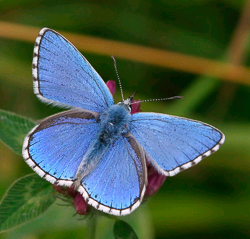 | 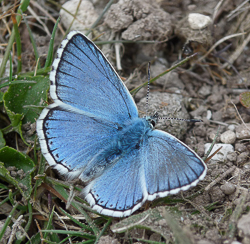 | 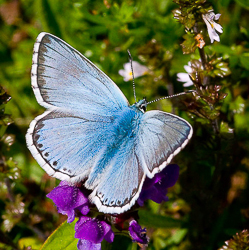 |
| Male Adonis Blue Image © Gary Richardson | Male ab. polonus Image © Neil Hulme | Male Chalkhill Blue Image © Peter Eeles |
If you thought that variation was confined to the adult butterfly only, then you'd be seriously mistaken! However, it has to be said that immature stages have been far less thoroughly studied than adult butterflies.
I'm not aware of any variation that occurs in the egg stage of British butterflies, but there may be evidence examples in foreign butterflies or moths.
Variation in the larval stage occurs in the Red Admiral as shown below. The larva has several colour forms, ranging from black, to greenish-brown to a very pale yellowish-green.
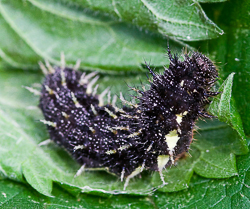 | 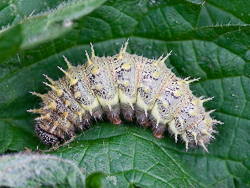 |
| Red Admiral Image © Peter Eeles | Red Admiral Image © Peter Eeles |
If we expand our horizons, differences between larvae of different subspecies of Swallowtail have been observed. The photo below contrasts larvae of the British Swallowtail, ssp. britannicus and that found in Israel, ssp. syriacus, the latter being much paler in colour than that found in Britain.
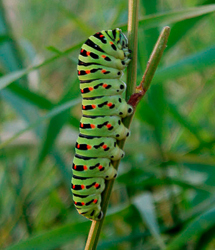 | 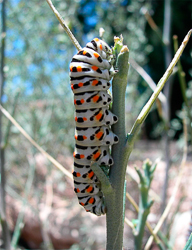 |
| Swallowtail ssp. Britannicus Image © Trevor Sawyer | Swallowtail ssp. syriacus (Israel) Image © Judith Beads |
There are several examples of variation in pupae. Keeping with the Swallowtail, two main colour forms of the pupa exist. One form is brown with black markings while the other is greenish-yellow. Other species also exhibit variation in the colour of the pupa, including Peacock, Orange-tip and Speckled Wood.
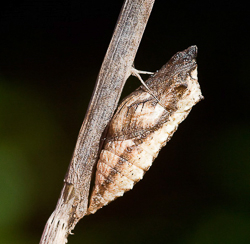 | 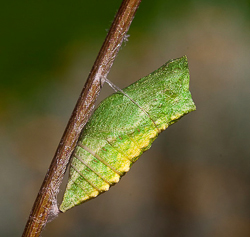 |
| Swallowtail Image © Peter Eeles | Swallowtail Image © Peter Eeles |
Incredible as it may sound, immature stages may also be considered aberrational - "The pupa of the sombre-looking aberration, ab. atratus (Bailey), in the Marsh Fritillary, is strikingly different in coloration from that of the normal form; the ground colour is pure white and the normal yellow markings are replaced by blackish maroon" [Harmer].
So you hopefully have two very big questions you want answered - why does such variation occur, and how does it occur (what are the mechanics)? A summary of the different types of variation, together with representative examples that will be discussed, is given in the checklist below. You should be able to extrapolate from these selected examples to other related variations mentioned (unfortunately, explaining every single variation would be an impossible task!).
| Variation | Representative Example |
|---|---|
| Sex-linked | Adonis Blue |
| Sex-linked - form | Silver-washed Fritillary (f. valesina) |
| Geographic | Large Heath (ssp. scotica, f. polydama, f. davus) |
| Seasonal - noticeable | Holly blue (female) |
| Seasonal - significant | Map (f. levana, f. prorsa) |
| Aberration - colour | Small Copper (ab. schmidtii) |
| Aberration - markings | Purple Emperor (ab. lugenda) |
| Aberration - mixed gynandromorph | Adonis Blue |
| Aberration - bilateral gynandromorph | Orange-tip |
| Aberration - hybrid | Adonis Blue x Chalkhill Blue (ab. polonus) |
| Immature Stages - larva | Red Admiral |
| Immature Stages - pupa | Swallowtail |
So why is it that the natural world shows us such a vast array of variation? For the answer we simply need to turn to Charles Darwin's "On the origin of species - by means of natural selection". The essence of Darwin's theory of evolution is that a population's environment will undoubtedly change over time and any population must adapt to survive. The adaptations are then either retained or lost based on natural selection. Those adaptations in the population that are considered favourable (since they provide an advantage in a given environment) will be retained (through reproduction) while those considered unfavourable will be lost. The emphasis on populations rather then individuals is deliberate since it is through sexual reproduction between individuals within an interbreeding population that natural selection takes place.
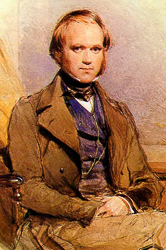 | 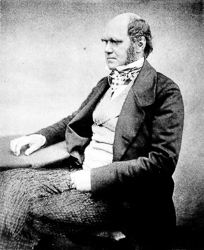 | 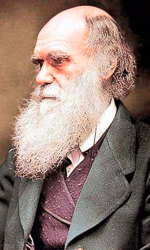 |
We should also recognise that Darwin's views on evolution are not universally accepted (see http://www.dissentfromdarwin.org). However, no broadly-acceptable alternatives for both the similarities and differences we see between species has been forthcoming, it would seem. Darwin's views on natural selection and evolution are accepted in this article.
Re-examining the earlier examples of variation, we should conclude that they all exist because of natural selection. In some way, they have all come about because they offer the individual (and population) some advantage in their environment such as reduced predation, increased fecundity (fertility) and improved mating success. However, the one exception is with regard to aberrations and this is discussed below.
Given this conclusion, let's revisit some of the examples. As we go through this exercise, we should also remember that there are no explanations for some variation we see around us. For example, it's easy to come up with a reason for the sexual dimorphism in the Adonis Blue but downright impossible to do the same for the spots on the forewings of the Northern Brown Argus ssp. artaxerxes! And yet this variation does exist. My conclusion is that nature is cleverer than human beings and, through natural selection, has determined that a particular variation provides the population with an advantage in its environment - we're just not clever enough to work out why!
As we saw, sex-linked variation varies from insignificant to significant depending on the species. Considering a species where the difference is significant, such the Adonis Blue, we find that the male is a bright blue and the female is typically a dark brown. It is generally believed that the reason for the blue colouring of the male is to be highly visible to a virgin female looking for a mate. The reason for the female being brown is to be inconspicuous and avoid predation, since it is the female that carries the precious cargo of eggs that are the next generation. Mate location and camouflage are probably two of the main drivers of sex-linked variation.
 |  |
| Male Adonis Blue Image © Peter Eeles | Female Adonis Blue Image © Peter Eeles |
It is more difficult to come up with a theory regarding the valesina form of Silver-washed Fritillary. However, it has been proven that this form of the female is at a disadvantage in its environment since it takes longer for it to be found by a male [Ford] since certain visual clues are missing (this also applies to the helice form of the Clouded Yellow female). Also, perhaps it is at an advantage in dense woodland where it can warm up more easily due to the darker colouring of the wings than a normal female and is therefore, presumably, more active in such woodland and earlier in the day.
 |  |
| Female Silver-washed Fritillary Image © Peter Eeles | Female Silver-washed Fritillary f. valesina Image © Peter Eeles |
As we saw, differences between populations that are geographically-separated can vary from subtle to significant. In the case of the Large Heath, the different size of spots found on the underside of the hindwings is a result of natural selection based on predation by birds [Brakefield2]. The cooler climate in the north, along with fewer hours of daylight, results in less-active adults whose plain undersides make them difficult to find while at rest. Adults further south, on the other hand, are much more active and are more-likely to attract the attention of birds as a result. In this case, the distinct eye spots deflect the bird's attention away from the body.
 |  |  |
| Large Heath ssp. scotica Image © Adrian Riley | Large Heath f. polydama Image © Paul Kipling | Large Heath f. davus Image © Peter Eeles |
It's difficult to explain the rationale for subtle seasonal variation and whether any natural selection is at play. For example, why is a second brood female Holly Blue slightly darker than the first?
 |  |
| Female Holly Blue (spring brood) Image © Peter Eeles | Female Holly Blue (summer brood) Image © Peter Eeles |
As we saw, the Map provides the most extreme form of seasonal variation. So why is the spring brood primarily orange, and the summer brood primarily black? A speculation is that the dark (prorsa) form has better camouflage in high summer where shaded areas are sought out, whereas the orange (levana) form has better camouflage in the cooler spring weather when this species flies in more-open areas.
 |  |
| Map f. levana Image © Peter Eeles | Map f. prorsa Image © Peter Eeles |
When it comes to natural selection, we should consider two classes of aberration - those that are passed from generation to generation in the gene pool, and those that are not.
Those aberrations caused by errors as the individual develops or the environment, are not influenced by natural selection since they are not part of the gene pool (and are not therefore inherited). As we shall see, this includes certain examples of colouring and markings (those that are environmentally-controlled), gynandromorphs and hybrids.
Those aberrations that are carried in the gene pool (and from generation to generation), and that are visible in terms of colour and markings, clearly do not provide the population with any advantage otherwise they would be pervasive. And this is where the term "aberration" really doesn't stand up to scrutiny. An individual is considered an aberration if it deviates from the norm. But if it becomes pervasive, it is the norm and therefore no longer an aberration! A case in point is ab. caeruleopunctata in the Small Copper (mentioned earlier) that has a row of blue spots above the copper marginal band on the hindwing. It could be argued that individuals without the blue spots are actually the aberration in some populations! However, answering the question of why this occurs, these aberrations should simply be seen as a reflection of the rich gene pool available that potentially allows populations to respond to changes in their environment.
 |  |
| Small Copper Image © Vince Massimo | Small Copper ab. caeruleopunctata Image © Peter Eeles |
Variation in immature stages is usually easily-explained. However, the difference in colouring between different Red Admiral larvae is not such a case, although several suggestions have been made. One is that the variation may not offer an advantage but, by the same token, does not offer a disadvantage! Another is that the different colouring may give one form an advantage should they move from leaf to leaf in daylight (despite spending most of their time in a rolled-up nettle leaf). Finally, the different forms could potentially "spread the risk" since a given predator may form a particular "search image" when looking for the larva.
 |  |
| Red Admiral Image © Peter Eeles | Red Admiral Image © Peter Eeles |
The different colouring found in Swallowtail pupae is much more easily explained and one that occurs in other species, such as the Peacock and Orange-tip. In all cases, the pupa is attempting to blend in with the background to avoid predation. For example, a Swallowtail larva that pupates on a dead plant stem will invariably be of the brown form, whereas those that pupate on a green plant stem will be invariably green. However, once the pupa has formed, it is unable to change its colour. For example, if a green pupa forms on a green plant stem and the stem subsequently turns brown, then the pupa will be highly visible.
 |  |
| Swallowtail Image © Peter Eeles | Swallowtail Image © Peter Eeles |
For many years it was thought that adaptation as a result of natural selection took place over long periods of time measured in hundreds if not thousands of years. However, scientists were amazed to find that populations of the Peppered Moth (Biston betularia) had lost the camouflage that gives the moth its name in manufacturing areas - resulting in a phenomenon referred to as industrial melanism - a process that had taken only 75 years or so.
The vast majority of Peppered Moths are light in colour, giving them good camouflage against light-coloured trees and lichens on which they rest. However, due to widespread pollution in industrial areas, many of the lichens died out and trees in the area became darkened by soot. This result in light-coloured moths (f. typica) becoming more susceptible to predation (due to a lack of camouflage), with darker individuals being at a distinct advantage, in their environment. Over time, darker (melanic) individuals (f. carbonaria) became the prominent form. More recently, the opposite phenomenon has taken place with improvements in the environment, with light-coloured moths once again becoming the prominent form. In the photos below, a light-coloured moth (f. typica) and dark moth (f. carbonaria) sit side-by-side on an unpolluted lichen-covered trunk in Dorset, and a soot-covered trunk near Birmingham [Kettlewell].
I make no apologies for the next example, of a foreign butterfly, which shows the extent of variation possible. This is the African Mocker Swallowtail (Papilio dardanus). In the figure below, the column on the left shows the male Mocker Swallowtail followed by three milkweed butterflies (relatives of the Monarch) that are distasteful to birds. The column on the right shows four Mocker Swallowtail females, each very different from the others - absolutely incredible variation! Males are more or less uniform but females come in at least 14 varieties, several of which might fly in the same region. This is an example of Batesian mimicry (first postulated by Henry Walter Bates) where a harmless species has evolved to imitate the warning signals of another.
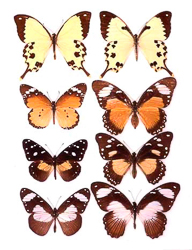 |
| African Mocker Swallowtail (papilio dardanus) |
From the small number of examples of variation given above, you probably already have a sense that variation stems from two sources. In simple terms, variation occurs as a result of heredity (specifically. the genes inherited from an individual's parents), the environment (such as temperature) or both.
Consequently, in order to fully-grasp the root causes of variation we need to cover several topics. Rest assured that your careful attention will reap dividends in terms of a better understanding of the natural world and some of the processes that make it tick.
One aspect of our lives that we share with a butterfly is that we both originate from a single fertilised egg (known as a zygote) that is the union of a sperm and an egg (both known as gametes). This fertilised egg is a single cell that divides again and again, creating new cells along the way, as the organism develops.
Cell: The smallest unit of living matter. All living things, including animals and plants, are made up of cells.
Gamete: A reproductive cell. Sperm cells and egg cells are both gametes.
Zygote: The initial cell of a new organism produced (by sexual reproduction) from the union of two gametes.
A cell has several parts to it, although we are most interested in the cell's nucleus. With the exception of sperm and egg cells, the nucleus of a cell contains several pairs of chromosomes (where one half of a pair is contributed by one of the parents).
Each chromosome is a strand of DNA and it is specific sections of this DNA that comprise the genes in which we're interested since, as we shall see, it is the genes that cause the expression of physical characteristics and ultimately much of the variation we see in the natural world. The total number of chromosomes varies from species to species and, according to [Ford], "Ö may be less than 10 and rarely exceeds a few dozen".
 |
Nucleus: A cell's "control centre" that contains the genetic material.
Chromosome: A structure in a cell nucleus that carries the genes. Each chromosome consists of one very long coiled and folded strand of DNA.
DNA (deoxyribonucleic acid): A large double-stranded molecule (an arrangement of atoms) carrying the genetic code.
Gene: The fundamental physical and functional unit of heredity (that carries information from one generation to the next) and that control one or more characteristics.
In humans, each cell nucleus contains 22 pairs of homologous chromosomes (where the members of each pair are identical in size, shape and position of genes) and a single pair of sex chromosomes (gametes). The nucleus of a human cell therefore contains 46 chromosomes in total.
Homologous Chromosome: One of a pair of chromosomes that is identical in size, shape and position of genes to its corresponding chromosome.
 |
| Human Chromosomes |
Another concept that needs to be introduced before giving some concrete examples (to put some "meat on the bones" - or should that be "genes on the chromosomes"?) is allele. An allele represents a particular form of a gene. For example, a Peacock butterfly might have an allele for a small eye spot on its hindwings. However, alleles come in pairs (one inherited from the father and the other from the mother). So what happens if one of the Peacock's alleles (inherited from one parent) is for a small eye spot, and the other allele (inherited from the other parent) is for a large eye spot? In short, it depends, as we'll see.
Allele: An alternative form of a gene.
If two alleles are the same (for example, they are both alleles for a large eye spot) then the organism is said to be homozygous with respect to this characteristic (and the butterfly is a homozygote in this respect). If the alleles are different, the organism is said to be heterozygous with respect to this characteristic (and the butterfly is considered a heterozygote in this respect).
Homozygote: An organism with identical alleles for a specific characteristic.
Heterozygote: An organism with different alleles for a specific characteristic.
In order to understand certain aspects of variation, we also need an appreciation of the mechanics by which new cells come into being. Most cell division is the result of a process known as mitosis where a complete replica of the parent cell is made (including a copy of the chromosomes and therefore the DNA and genes). If these cells are genetically equivalent (since they are all derived, ultimately, from the original fertilised egg) then you may be wondering how these cells perform different roles in an organism. For example, a brain cell is very different to a muscle cell. The answer is gene regulation that ultimately controls the creation of proteins that contribute to the physical structure of the organism.
However, reproductive cells (egg and sperm cells, the gametes) are created from cells in the reproductive organs using a different process called meiosis and have half the number of chromosomes (in humans, there are 23 chromosomes in total in both egg and sperm cells, not the 46 found in other cells). The full complement of chromosomes is restored when the gametes unite (when a sperm fertilises an egg). The most important aspect of meiosis to remember is this: when the gametes are formed (from a cell in the reproductive organs) there is an equal chance of it receiving a gene (and therefore allele) from one chromosome as it is the other (paired chromosome). This apparently-simplistic statement is reinforced when we consider other phenomena, such as crossing over, and diminished when we consider others, such as linkage. Such topics are outside the scope of this paper (but are mentioned in the "Other Topics" section below).
Mitosis: The process of cell division in which two daughter cells are formed, each with identical chromosomes to that of the parent cell.
Meiosis: The process of cell division in which reproductive cells are formed, each containing half the number of chromosomes in the parent cell.
Meiosis is illustrated in the figure below where we can see a cell containing two pairs of homologous (paired) chromosomes, one pair containing alleles A and a, and the other containing alleles B and b. As we can see, there is an equal probability of one of the resulting four gametes containing the combination AB, Ab, aB or ab. Through this process organisms can produce offspring with new combinations of maternal and paternal traits (that may or may not contribute to or enhance survival) that provides a key to understanding variation.
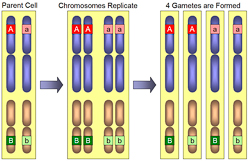 |
This example demonstrates Mendel's "first law" (the law of segregation) which states that only one copy of each gene (which are carried on the chromosomes) is contained in each gamete. Gregor Mendel was an Augustinian priest whose studies on the selective breeding of the garden pea (in the 1860s) provide the foundation of modern genetics. Mendel is one of the science "greats" and I highly recommend the MIT (Massachusetts Institute of Technology) lectures on genetics [Lander] if you want to know more.
 |
| Gregor Johann Mendel |
So let's get to some real examples. Those given below are refined from those in [Ford] where the Small Copper is used as an example. I see no reason for selecting different examples; on the contrary, imitation is the sincerest form of flattery.
As an aside, the field of genetics uses two specific terms to distinguish between an organism's heredity and what that heredity produces. These terms are genotype and phenotype. It also has to be said that most genetic variation is not expressed in any observable characteristic.
Genotype: The inherited instructions an organism carries within its genetic code. Not all organisms with the same genotype look or act the same way because appearance and behaviour are modified by the environment. Similarly, not all organisms that look alike necessarily have the same genotype.
Phenotype: The observable expression of the genotype.
The first two examples demonstrate the basic mechanics of inheritance and from which all other examples derive. As shown earlier, the extremely rare aberration schmidtii in the Small Copper has the copper colouring replaced by a silvery white. However, in order for this character to be visible in the adult butterfly, both alleles for this characteristic (there are two - one for each chromosome in a pair) need to be schmidtii due to dominance. Essentially, if one of the alleles is normal, and the other schmidtii, then the individual will appear normal because the normal copper colouring is dominant and the schmidtii colouring is recessive. In summary, a schmidtii aberration can only arise if both alleles inherited from the parents are schmidtii.
Dominant Allele: An allele that is expressed in the phenotype even if the corresponding allele is not identical.
Recessive Allele: An allele that is expressed in the phenotype only when the corresponding allele is identical.
So let's put this knowledge to effect by considering a pairing between a Small Copper ab. schmidtii and a normal Small Copper. In order to show how the alleles are passed from generation to generation we need to identify them. The convention is that each allele is named with a single letter that takes the first letter of the name of the variation (in this case "s" for "schmidtii"). A lowercase letter represents the recessive condition (in this case, schmidtii is denoted by "s") and an uppercase letter represents the dominant condition (in this case, normal is denoted by "S"). And so a normal Small Copper that contains dominant alleles only is labelled "SS" (the two alleles inherited from the parents are given) and ab. schmidtii that contains recessive genes only is labelled "ss". If the Small Copper is a heterozygote, then it will contain both a recessive and a dominant allele and would be labelled "Ss" (and appear normal).
The figure below is known as a Punnett Square (a grid used to show the gametes of each parent and their possible offspring) that helps visualise a cross between two individuals. Here we can see the result of a pairing between a normal male Small Copper and an ab. schmidtii female Small Copper. The male will donate sperm that has alleles that are both dominant, and the female will donate eggs that are both recessive. The resulting offspring are therefore all heterozygotes (Ss) since they all receive a dominant allele from the father and a recessive allele from the mother. Because of dominance, they will all appear normal. If dominance were absent (which is the case in some species with regard to colour) then the heterozygote would produce an intermediate colour form (although this is unknown in the British butterflies).
 |
Now let's see what happens if two of these offspring were to pair, as shown below, since this will allow various observations to be made. We can see that we end up with offspring in the ratio of 1:2:1 (dominant homozygote, heterozygote, ab. schmidtii homozygote), although the visible ratio would appear to be 3:1 (normal, ab. schmidtii). More importantly, we can see that the variation present in the original pairing (ab. schmidtii) completely disappeared in the first generation of offspring (which were all heterozygotes that appeared normal), but reappeared in the next generation. It's all in the genes! Which explains why certain aberrations appear in a given population (and gene pool) more frequently than others and are sometimes absent altogether.
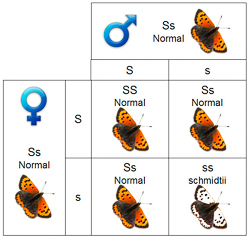 |
Considering more-complex interactions will allow us to explain some additional phenomena we see in the natural world. So let's consider the situation where an ab. schmidtii individual crosses with another rare aberration, ab. obsoleta, where the copper band on the hindwing is missing (although this pairing is somewhat theoretical, a similar cross between ab. radiata and ab. pallidula has been performed in captivity [Harmer]). Such a pairing is shown in the figure below although, this time, we're showing two pairs of alleles ("s" representing schmidtii and "o" representing obsoleta). As we'd expect, we end up with offspring that all appear normal, but are actually heterozygous with respect to both characteristics.
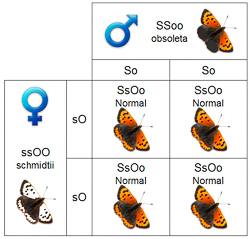 |
Now let's see what happens when these offspring pair as shown below. Both male and female will contribute four types of reproductive cells: SO, So, sO and so (these are in equal proportions since an S is as likely to "segregate" with an O as an o, and the same goes for an s). We can see that we can combine sperm and egg in 16 different ways, producing 9 distinct types (SSOO, SSoo, SsOO, SSOo, SsOo, ssOo, Ssoo, ssOO and ssoo, in the respective ratios of 1:1:2:2:4:2:2:1:1). This produces 4 visibly distinct groups of offspring (normal, ab. obsoleta, ab. schmidtii and ab. obsoleta + schmidtii, in the respective ratios of 9:3:3:1). In essence, this example is simply an extension of the previous example but further reinforces that different characteristics are inherited independently. Any ab. obsoleta + schmidtii would be an extremely rare creature and is known as a double recessive. However, such aberrations are occasionally found in the wild.
Double recessive: A phenotype exhibiting the effects of two recessive alleles.
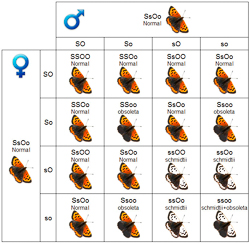 |
We now turn our attention to the inheritance of a characteristic that occasionally results in specific types of variation. This is the inheritance of sex.
As in humans, the inheritance of sex is controlled by a particular pair of chromosomes. In humans, an XX pair of chromosomes (so-called based on their shape under the microscope) is present in the female, and an XY pair is found in the male. This situation is reversed in insects, where it is the male that has the XX combination and the female XY. Also, in humans, it is the presence of hormones (secreted by glands in the reproductive organs) that influence the sex-influenced parts of the body. Again, this is quite different in insects, where the sex of a given part of the body is simply influenced by the chromosomes present in a cell (and not by hormones). Specifically, sex is wholly determined based on the number of X chromosomes (the Y chromosome being irrelevant in terms of sex). If two X chromosomes are present, the cell is deemed to be male. If one X chromosome is present, it is considered female. The figure below shows a how male and female combine to produce offspring in, of course, a 1:1 ratio of male to female.
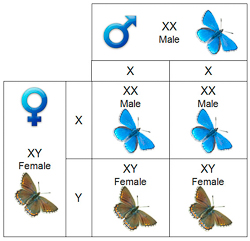 |
Things start to get interesting when abnormalities arise in the copying of the X and Y chromosomes during cell division. An example is when chromosomes fail to separate correctly during cell division. A male cell (XX) may divide, but the sex chromosomes fail to separate correctly, resulting in a cell with three X chromosomes, which dies, and another with one X chromosome which is considered female. Similarly, a female cell (XY) divides into child cells containing two Y chromosomes (which dies) and another containing two X chromosomes and which is considered male. In both cases we end up with a mixed gynandromorph - an individual of one sex exhibiting aspects of the other.
 |
| Adonis Blue Mixed Gynandromorph Image © Vince Massimo |
The extent to which a gynandromorph exhibits aspects of each sex is dependent on the point at which the abnormality occurs. If late in the development of the individual, then there will be very little of the "opposite" sex since much of the cell division will already have happened. However, one interesting aspect of development in insects is that the first cell division of the fertilised egg results in one cell that is responsible for the development of left side of the body, and the other responsible for the right. If the abnormality occurs in this first cell division, then we end up with an individual that is decidedly male on one side and female on the other - a bilateral gynandromorph.
 |  |
| Silver-washed Fritillary Bilateral Gynandromorph Image © Susie Milbank | Orange-tip Bilateral Gynandromorph Image © Peter Eeles |
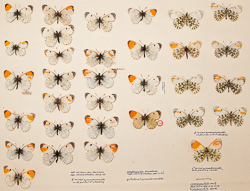 |
| A Cabinet of Curiosities! Image © Peter Eeles |
There are many examples where the action of a gene is influenced by the sex of the individual. This is known as sex-limited inheritance (also known as sex-controlled inheritance) and, in butterflies, typically affects colour, wing shape, markings and behaviour. The resulting sexual dimorphism results from the action of sex-limited genes which, although present in both sexes, only have an effect in one sex. We have two examples in the British Isles - the valesina form of the female Silver-washed Fritillary and the helice form of the female Clouded Yellow, where the named form is only expressed in the female. In both cases, the allele controlling the form is dominant (which has been proven through captive rearing and examining the ratios of offspring) rather than recessive (which is what we might expect given the ratios we see in the wild, which we'll come back to).
Now let's consider a couple of pairings. The figure below shows a pairing of a normal male (that doesn't carry the valesina allele) with a valesina female. In this example, we're considering both the sex chromosomes (X and Y), as well as the allele for wing colour (represented using the letter V). Since the male is XXvv, the only combination of alleles in the gametes is Xv (as shown). We can see that we get equal numbers of normal and valesina females in the offspring.
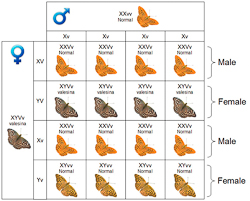 |
Were the male to also carry the valesina allele, as shown in the figure below, then we should expect to get a ratio of 1:3 in terms of normal and valesina females in the offspring.
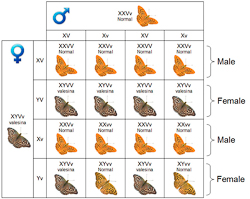 |
If we take this further, where the female is homozygous with respect to the valesina allele, then we would expect all female offspring to be valesina. However, we never see such ratios in the wild. Why is that? It has been found that the valesina form of female is actually at a disadvantage in its environment. Specifically, the optical stimulus provided by the female to attract a mate (a distant fluttering brown object) is absent in the valesina female, giving rise to a form of natural selection known as sexual selection. As a result, the female has to wait longer to be mated (she finds a mate when nectaring at bramble, for example). There is therefore a longer time between emerging and egg laying as a result, leading to a greater possibility of predation and therefore less time for egg laying. Fundamentally, the valesina allele may be "dominant" genetically, but is unable to capitalise on this dominance in its environment. In fact, Ford suggests that the VV homozygote might be ìdelicate, sterile or altogether unviableî [Ford]. This inability for a potentially key source of the valesina allele to propagate (since all offspring would carry it) would result in a significant reduction in the number of valesina females experienced in the field.
Given the explanations above, it's easy to see how we might encounter an individual that comprises a number of different variations, although this is an extremely rare occurrence. For example, specimens of the Silver-washed Fritillary are known with one half male, the other half the valesina form of female. This is clearly the combination of a bilateral gynandromorph and the valesina form of the female.
The discussion so far has focused on relatively-simple interactions involving no more than two pairs of genes. To some extent, this was simply to introduce the basics of genetics (although it did allow some specific types of variation to be discussed). However, there are inevitably more complex interactions that occur.
We've considered the situation where two alleles influence two separate characters (ab. schmidtii and ab. obsoleta). Let's now consider how two alleles influence a single character. There is a real-world example of this situation, found in the Jersey Tiger moth (Callimorpha quadripunctaria). The figure below [Brakefield] shows two pairs of alleles (Y - yellow and R - red) acting on the same character, controlling the colour of the hindwings. We can see that we get three distinct types resulting. The dominant Y allele controls the expression of a colour other than the original yellow pigment. If the Y allele is present then the R allele controls whether the resulting colour is red (R) or orange (r).
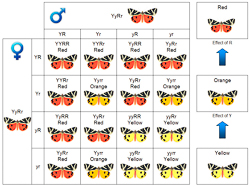 |
Now if you think that is complex, imagine the case where we are dealing with three or more pairs of genes all acting on the same character where dominance is completely absent. It would be impossible to determine the effect of one particular gene. Rather, we would expect to see a graded series of variation. We can therefore see that there is a spectrum of effects that we might encounter in nature - where a small number of genes at play results in a series of distinct steps, whereas a large number of genes at play results in a much smoother gradient.
As it happens, such a series is frequently-encountered in characters where we perceive a continuum, such as wingspan, colours and markings. Examples include the size of the eye spot on the hindwings of the Large Heath (where different populations show different, but consistent, variation - leading to a cline), the dotted line found on the underside of the Green Hairstreak and numerous other examples. An extreme example is the variation in the amount of blue found on the upperside of the female Adonis Blue (as shown below), giving rise to several named aberrations that suggests there are distinct steps in the gradient we see and, therefore, actually a relatively-small number of genes at play, with none expressing dominance (otherwise we wouldn't see the extent of variation that we do).
It has been suggested that bluish females are quicker to find a mate due to the optical stimulus, but are also more-heavily predated. Brown females, on the other hand, take longer to find a mate, but are less-heavily predated [Brakefield].
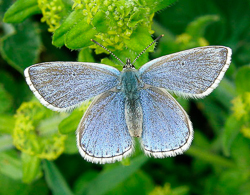 | 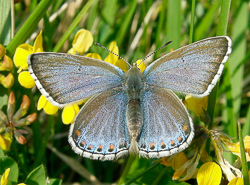 | 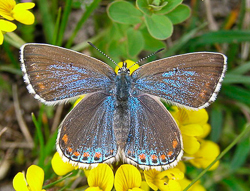 |
| Image © Vince Massimo | Image © Vince Massimo | Image © Vince Massimo |
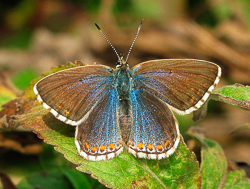 | 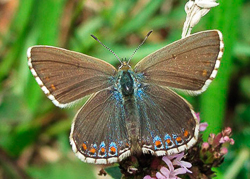 | 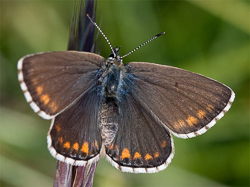 |
| Image © Vince Massimo | Image © Vince Massimo | Image © Peter Eeles |
However, we should also remember that individuals in certain populations differ consistently, rather than exhibiting a gradient. For example, the Grayling and Silver-studded Blue populations found on the Great Orme in North Wales contain individuals that are distinctly smaller than those found in other populations. These populations also emerge earlier in the year. Such a difference cannot be the result of the environment or a complex genetic interaction, therefore, but a simple and inherited genetic interaction as described earlier, possibly one that speeds up development resulting in individuals that emerge early in the season.
A particularly complex genetic interaction occurs when individuals of two different species mate. The "gene complex" that arises is truly mind-boggling and it would seem that the only conclusions that we can draw from such events is that any inter-species offspring are usually infertile, possibly a result of the level of "disruption" in their genetic makeup.
As surmised by Darwin following his extensive travels on HMS Beagle, geographic isolation is the root cause of the evolution of new species (speciation). Why? Because geographic isolation leads to the genetic isolation that defines a species. Each population, through natural selection, will evolve to survive in its environment. If two populations experience different environments, then each population will adapt in different ways. Such adaptations may result in the evolution of incompatibilities between populations that prevents successful reproduction between their members.
For example, populations might fly at different times of the year, take advantage of different habitats, exhibit different mating rituals and signals, have incompatible genitalia preventing the physical transfer of sperm to egg and, finally, be chemically incompatible, resulting in sperm death or death of the fertilised egg.
A discussion of genetics would not be complete were the subject of mutation to be omitted. A mutation is a permanent change in the DNA sequence that makes up a gene (that is not simply a result of understood mechanisms such as "crossing over") and can be caused by several factors, including radiation, viruses, chemicals and errors that occur during cell division (and DNA replication). Mutations range in size from a single DNA building block to a large segment of a chromosome.
In reality, mutation is an extraordinarily rare event. Ford suggests that a given gene mutation occurs in the region of between one individual in 50,000 and one individual in a million. As a result, any "mutant" that results is unlikely to be encountered by observers. However, the subject of mutation is of vital importance when considering evolution since it potentially modifies the gene pool.
Even in the absence of mutation, it should be recognised that there is still a vast reservoir of genes (and genetic combinations) that can occur within a given population (as a result of sexual reproduction) that, in addition to environmental factors, supplies the vast majority of variation we encounter in the world around us.
Despite such lengthy discussion of genetics, we've only scratched the surface! If you do want to know more then the references provided at the end of this article are recommended reading, as is the wealth of information found on the Internet, where topics such as crossing over (where chromosomes exchange genetic information during meiosis), linkage (where genes are not wholly independent when inherited), multiple alleles (where an allele can exist in more than two states), modifier genes (where a gene modifies the effects of another gene) and gene complexes (where genes interact with one another as a unit to influence various characters) can be found. Suffice to say, there is still much to learn with regard to the genetic underpinnings of the variation we see in our British butterflies, especially when multiple factors are concurrently at play.
The preceding discussion may give the impression that all physical characteristics exhibited by an organism (and any variation) stem from its genes. While the heredity of an organism certainly has a significant part to play, this is not the whole picture since the environment can modify the processes by which genes are passed from one generation to the next and the synthesis of proteins. Factors such as temperature and nutrition all, potentially, have an influence.
For example, a particular caterpillar may have the appropriate genetic composition to produce a relatively-large adult butterfly. However, if the caterpillar is under-nourished for some reason (such as having insufficient food plant in its environment) then an undersized adult butterfly may result. However, the genetic composition of the butterfly remains constant and is passed to any offspring unchanged, just as the child of a bodybuilder doesn't benefit from the workouts of their parents!
The blacks and browns found in the colouring of many butterflies is the result of the production of a pigment known as melanin (the same substance that gives us our skin and hair colour), a process that is influenced by temperature.
Temperature is a factor in some of the seasonal variation we see. For example, the spring broods of Small White, Large White and Green-veined White are noticeably lighter than the summer broods, possibly as a result of individuals pupating in the autumn in much cooler conditions than those that pupate in mid summer and when one of the key agents in the production of melanin (an amino acid, tyrosine) is laid down. Another example of temperature-related variation is the difference we see between spring and summer broods of the Holly Blue, where females of the summer brood are slightly darker.
 |  |
| Female Holly Blue (spring brood) Image © Peter Eeles | Female Holly Blue (summer brood) Image © Peter Eeles |
It has also been shown that a significant variation can occur as a result of "extreme shocks of either heat or cold during the last 24 hours of the larval stage and the first 48 hours of the pupal stage" [Vigus].
 |  |
| Male Purple Emperor Image © Peter Eeles | Male Purple Emperor ab. lugenda Image © Matthew Oates |
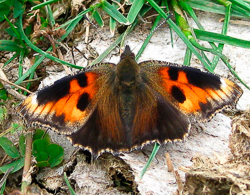 | 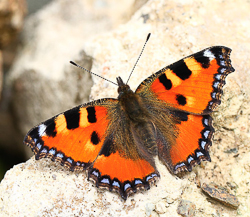 |
| Small Tortoiseshell (increased melanin) Image © Agnes Rutter | Small Tortoiseshell (reduced melanin) Image © Gary Palmer |
The amount of daylight can also affect an individual's development and appearance. An extreme example of seasonal variation caused by photoperiod is found in the Map butterfly. As we saw earlier, the spring form is primarily orange in colour, giving the appearance of a small fritillary, whereas the summer form looks more like a small White Admiral. As it happens, it has been shown that the cause of this "switch" is down to day length [Brakefield]. Larvae exposed to long day lengths result in the dark form (f. prorsa) characteristic of the summer brood. Those exposed to a short day length result in the orange form (f. levana) characteristic of the spring brood.
 |  |
| Map f. levana Image © Peter Eeles | Map f. prorsa Image © Peter Eeles |
It has been shown that the larvae of certain species are sensitive to a colour-stimulus for the short period between the cessation of feeding and the construction of the silk pad on which the pupa will form. In species such as the Swallowtail, a larva preparing to pupate on a green stem will result in a green pupa, and a larva preparing to pupate on a brown stem will result in a brown pupa. This is clearly designed to match the surroundings.
 |  |
| Swallowtail Image © Peter Eeles | Swallowtail Image © Peter Eeles |
It has also been found [Brakefield] that certain continental species vary their colour based not on an optical stimulus but a textural stimulus. Larvae of the Common Mormon (Papilio polytes) produce green pupae if on a smooth surface, and brown pupae if on a rough surface. It is believed that this corresponds to textures found in the wild, where green surfaces are typically smooth and where brown surfaces are relatively rough.
In summary, the scope for variation is huge, driven by both heredity and the environment. The table below summarizes the rationale for any variance (aberrations are considered irrelevant since these are generally unintentional "one offs" and are not typically carried in the gene pool) and the different mechanisms at play.
| Variation | Representative Example | Why Vary? | Mechanics |
|---|---|---|---|
| Sex-linked | Adonis Blue | Mate location (male), camouflage (female) | Number of X chromosomes present |
| Sex-linked - form | Silver-washed Fritillary (f. valesina) | More active in dense woodland? | Dominant gene |
| Geographic | Large Heath (ssp. scotica, f. polydama, f. davus) | Camouflage | Complex genetic interaction |
| Seasonal - noticeable | Holly blue (female) | Camouflage | Photoperiod |
| Seasonal - significant | Map (f. levana, f. prorsa) | Camouflage | Photoperiod |
| Aberration - colour | Small Copper (ab. schmidtii) | Irrelevant | Recessive gene |
| Aberration - markings | Purple Emperor (ab. lugenda) | Irrelevant | Temperature shock |
| Aberration - mixed gynandromorph | Adonis Blue | Irrelevant | Error in cell division |
| Aberration - bilateral gynandromorph | Orange-tip | Irrelevant | Error in first cell division |
| Aberration - hybrid | Adonis Blue x Chalkhill Blue (ab. polonus) | Irrelevant | The offspring of 2 different species |
| Immature Stages - larva | Red Admiral | Unknown | Unknown |
| Immature Stages - pupa | Swallowtail | Camouflage | Colour of substrate |
Having studied this subject for some time, I'd like to make some concluding remarks. Yes, the British Lepidoptera is one of the most-studied groups of creatures on the planet. Yes, we have a paucity of species when compared with other regions. My view, however, is that we are therefore at an advantage since our in-depth understanding of a relatively-small number of species means that we are able to delve deeper, and the knowledge that we gain can benefit our entire planet. Our love of (and interest in) butterflies and moths really doesn't get more compelling than that.